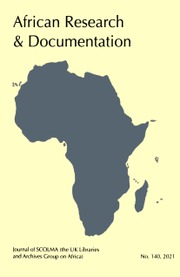No CrossRef data available.
Article contents
Obscured if Not Hidden: Records Relating to Africa in the National Archives of the Uk (TNA)
Published online by Cambridge University Press: 25 April 2022
Extract
In August 1841 twelve little boys boarded the British steam ship Albert. They were sons of the village chief at Aboh on the River Niger. The ship's surgeon, James McWilliam, noted that they were about the same age, and had been circumcised. He added: “many of them had the hair cut close or shaved leaving tufts and lines describing diamonds and other angular figures …” The drawing in figure 1 is by John Duncan, the ship's master at arms. McWilliam describes the chief and his wives - their physical appearances, clothing and ornamentation, commenting in particular on their coral jewellery. He writes about a ceremony marking the signing of a treaty.
Information
- Type
- Articles
- Information
- Copyright
- Copyright © African Research & Documentation 2013
References
Notes
1 This article is based on a paper delivered at the 2013 SCOLMA Conference, ‘Hidden Archives in African Studies’
2 Rush, Jill & Mandy, Banton, ‘Improving access to modern African sources at the National Archives of the United Kingdom’, African Research & Documentation No. 93 2003, pp. 39-46.Google Scholar
3 Foreign Office Correspondence 1906, Part 1, Africa Department (FO 367/1-35), (The List and Index Society, No. 338, 2010), ISBN 978-1-906875-23-7
4 Banton, Mandy (2012): ‘Destroy? “Migrate“? Conceal? British Strategies for the Disposal of Sensitive Records of Colonial Administrations at Independence’, Journal of Imperial and Commonwealth History, 40:2, 321-335.CrossRefGoogle Scholar

